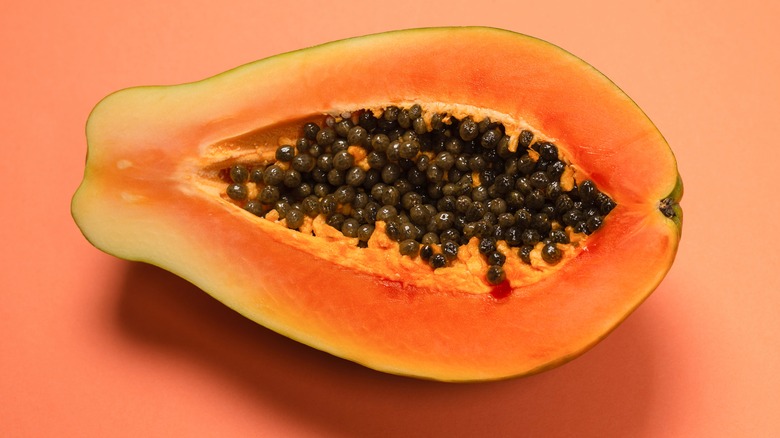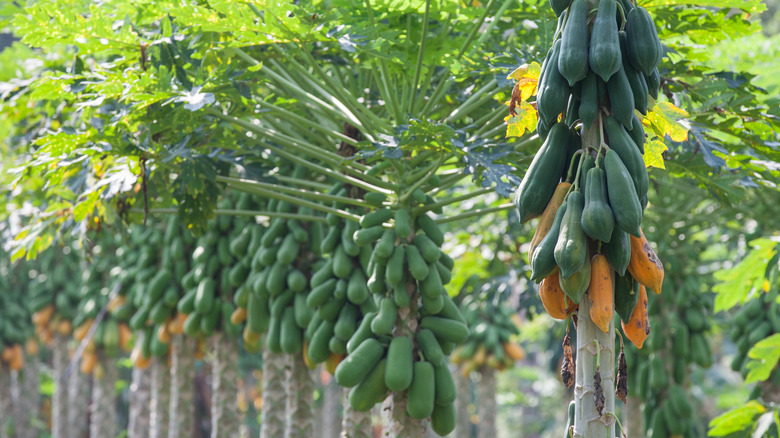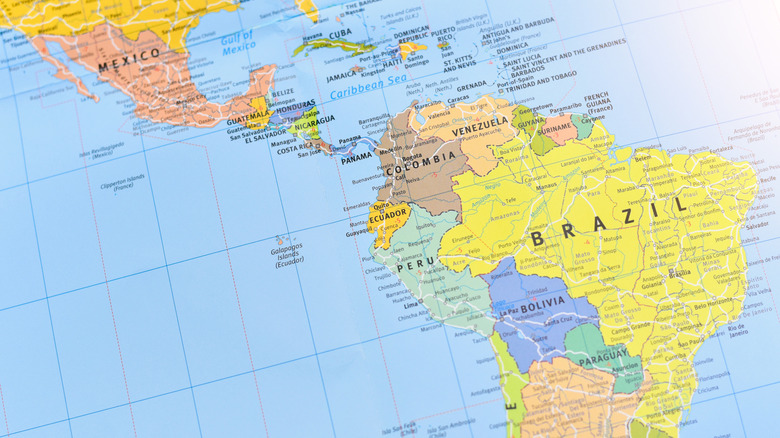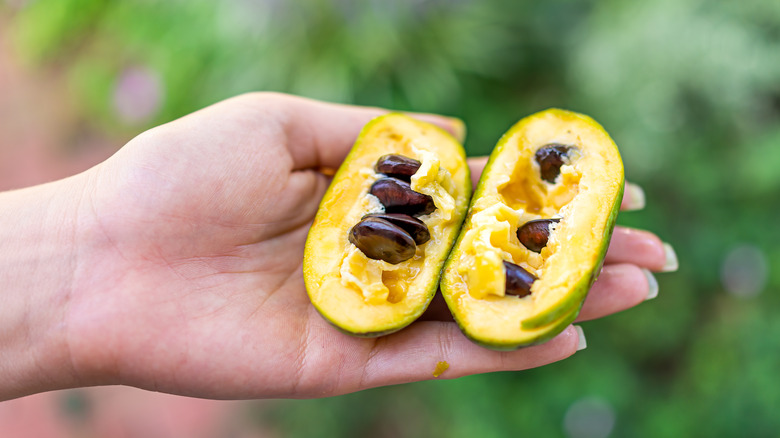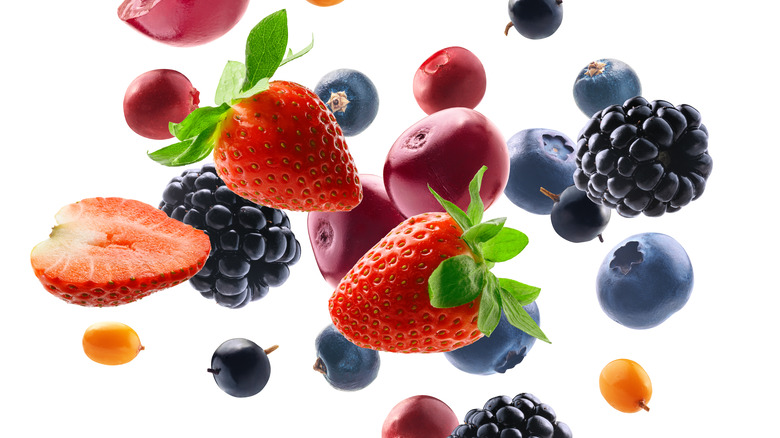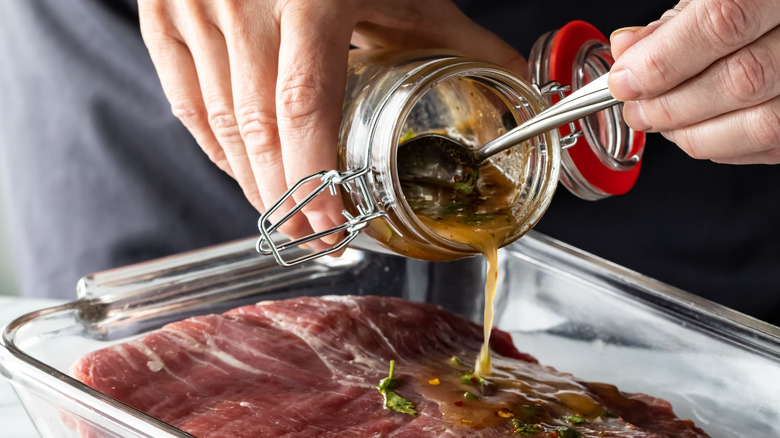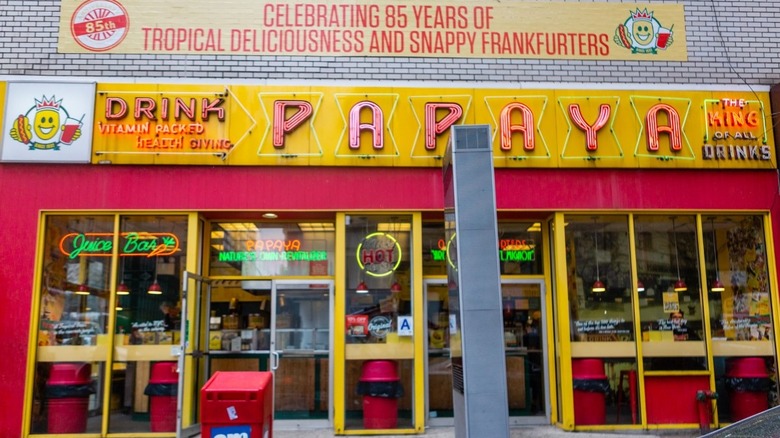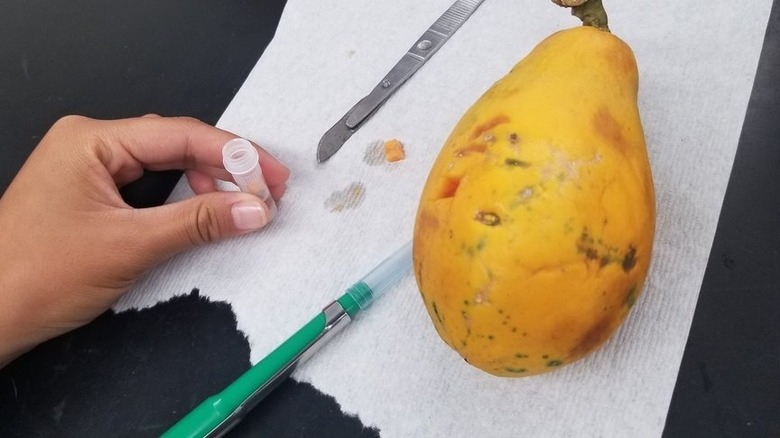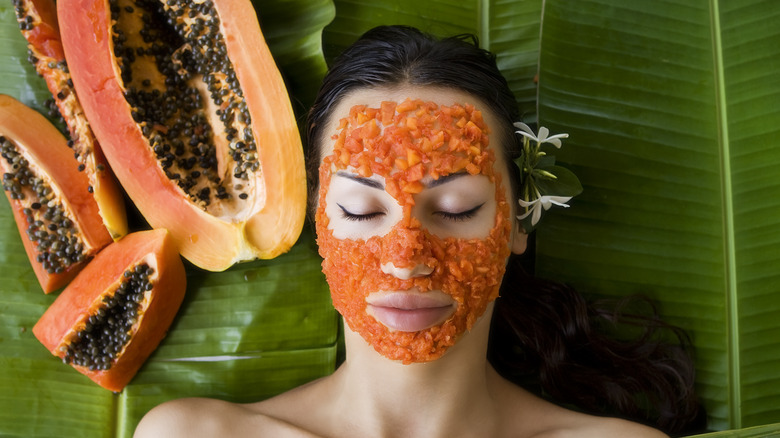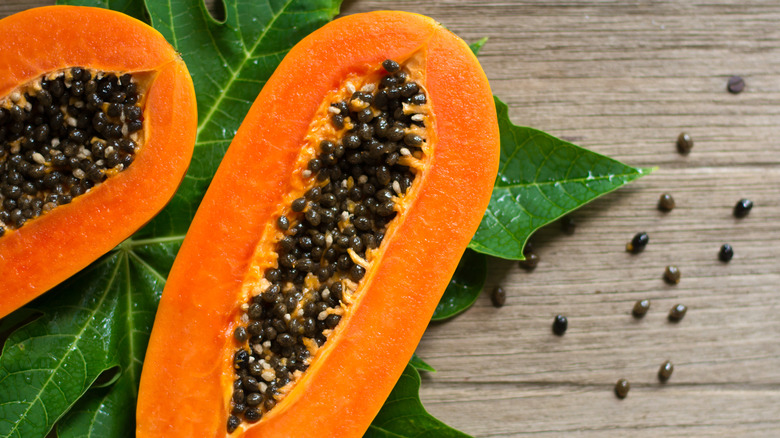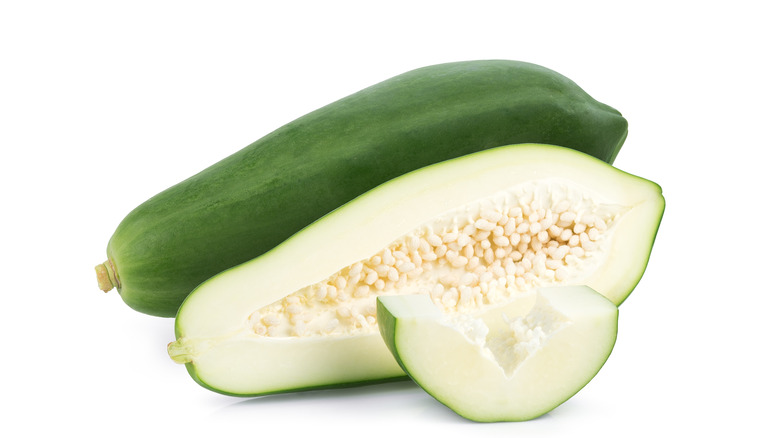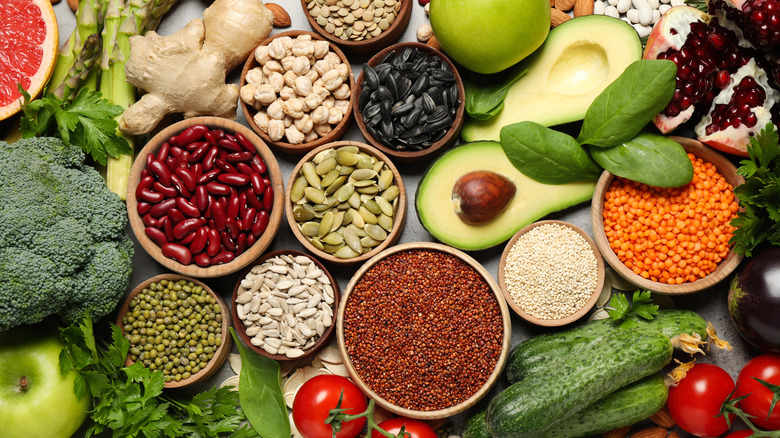What You Probably Didn't Know About Papayas
We may receive a commission on purchases made from links.
If you get tired of buying the same old fruits every time you go to the grocery store, it might be time to branch out. It might be time for something a little tropical, like the papaya, perhaps. According to the University of Florida, papaya has been gaining in popularity globally and is now the third most traded tropical fruit behind the mango and the pineapple.
Papayas are cylindrical-shaped, green-skinned fruits. The flesh of the fruit is a deep orange color and contains many black seeds in the inner cavity. According to The New Tropic, papayas taste like melons, only less sweet, and have a spicy kick to them. Additionally, they are loaded with antioxidants, anti-inflammatory properties, and health benefits (via Healthline). There is a lot about papayas you might not know, but as it gains popularity, it is time to crack open this fruit and see what it has to offer.
Papayas are native to tropical America
The papaya is believed to be native to southern Mexico or the lowlands of eastern Central America (via the American Indian Health and Diet Project and the Prince George County Public Schools). Today, they are still grown in the Americas, as well as in tropical areas around the world. According to the Western Institute of Food Safety & Security, 75% of the world's papayas are produced in just 10 countries, with India leading the world in the fruit's production. Brazil, Mexico, Indonesia, and Nigeria are also top producers.
Within the United States, papayas are grown in Florida, Texas, California, and Hawaii. Hawaii's climate is the most conducive to papaya production, and they are typically able to be grown year-round. However, even with these production areas, the United States only makes up 0.1% of the world's papaya production. That being said, Americans love the taste of this tropical fruit and are the largest importer of it in the world.
The name comes from the Carib word
The name papaya is derived from the Carib word for the fruit, "ababai" (via Prince George County Public Schools). Carib is the name of the Indigenous Americans who inhabited the South American Coast and Caribbean islands. It was here that Spanish and Portuguese colonizers first encountered the fruit in the 1500s and 1600s (via Web MD). They loved it so much that they took seeds to other areas with warm enough climates to grow them. This included regions such as the Philippines and India, where papayas are still prevalent today. In new places, the name "ababai" evolved to the similar sounding "papaya."
The name has evolved slightly differently in different parts of the world. In Australia, for example, the fruit is called a pawpaw. In some parts of Asia, it is called kepaya, tapaya, or lapaya. Each of these is a play off the original Carib word (via Web MD).
Papayas are not that pawpaw
Papayas have lent their name to another green-skinned fruit, which can cause some confusion. In some countries, the tropical fruit papaya is called a pawpaw (via Practical Primate). When we talk about the tropical papaya, we refer to the fruit with the Latin name Carica papaya. The other fruit, though, is the much lesser known North American pawpaw, or Asimina triloba.
To make matters even more confusing, the North American pawpaw derives its name from the papaya (via the Arnold Arboretum of Harvard University). When the tree was first examined by Hernando de Soto's expedition to North America in 1541, they noticed some visual similarities between the two fruits: Both grow in trees, have thick green skin, and offer a tropical flavor. This led to them naming the fruit in a similar fashion. Unfortunately, in parts of the world, such as Australia and New Zealand, this has caused some confusion between the two fruits.
There are some distinctions, though. The interior of the North American pawpaw bares a yellowish color instead of the papaya's orange, and its flesh is so sweet and creamy it bares the common name "custard apple."
Papayas are technically berries
Most people think of berries as little round things to pop in your mouth handfuls at a time. We do not recommend doing this with papaya. It might surprise you to discover, though, that the papaya is, botanically speaking, a berry, according to the Western Institute of Food Safety and Security.
According to Britannica, a berry is defined as a fruit that contains many seeds, is derived from a single flower ovary, and often has an inner fruit that does not offer much separation between the middle layers. The papaya meets all of these requirements as they are filled with seeds, produced from a single flower, and have a unified center. Other fruits, such as bananas, grapes, and tomatoes, also fit the classification of berry, despite not being thought of as them.
Ironically, fruits that are commonly considered berries, such as raspberries and strawberries, are not actual berries, as they are made up of many smaller fruits instead of a single fruit as defined as a berry.
Papaya can be a meat tenderizer
Papaya is a fruit of many uses. What many people do not know is that it can be used as a meat tenderizer. Raw papaya contains an enzyme called papain, which helps to break down proteins into peptides and amino acids, per Healthline. According to Cuisine at Home, to use papaya as a meat tenderizer, you must peel it, scoop out the seeds, puree the flesh, and spread it on the meat you are tenderizing. Then, allow it to sit for three hours before scraping it off and cooking the meat.
For those looking for a little less effort, some companies, such as Indus Farms, make Papaya Fruit Powder. Among other things, they specifically label "meat tenderizer" as one of the popular uses.
While it may seem odd to use a fruit to tenderize meat, a study presented at the International Conference on Food Science and Technology found that meat treated with papaya leaf, which also contains papain, did result in definable damage to the collagen fibers and was an effective meat tenderizer.
Papaya juice and hot dogs have become quite the pair
What may seem to be a non-standard paring has become a cultural phenomenon in New York City as papaya juice has become a popular drink to pair with hot dogs. According to The New York Times, the story starts in the 1930s when Greek immigrant Gus Poulos took a trip to Florida and tried tropical fruit for the first time. Enthralled with the flavor and a cunning businessman, Poulos decided to open a tropical fruit stand in Brooklyn, New York, called Hawaiian Tropical Drinks. By the 1940s, he changed the name to Papaya King and opened a store in the Upper East Side. Shortly after opening, Poulos was struck by another bout of inspiration and added hot dogs to the menu.
This solidified a trend of papaya fruit and hot dogs, which have become an unlikely New York staple. Papaya King is still around today, though as of September 2022 it was in danger of being closed down due to a developer purchasing the building and land (via the Oberserver). Seeing the institution close would be a tragedy, as it inspired a food trend that spawned numerous papaya and hot dog eateries, such as Gray's Papaya and Papaya Dog.
Papayas were the first GMO fruit sold in the United States
Papaya plays an important role in the history of genetically modified foods in the United States. While the debate on GMOs remains hot, it is worth noting that the papaya would not be where it is today without them. According to Food Insight, a virus called ringspot began attacking papayas in Hawaii starting in the 1940s. By the 1990s, the virus had reached nearly all areas growing papayas, dropping almost 50% of production.
A Hawaiian born scientist for Cornell University by the name of Dennis Gonsalves began working with a team of researchers to find a solution (via Cornell University). In 1985 the group started working to develop a new type of papaya that would be resistant to ringspot. By 1998 they were able to release the Rainbow papaya to the public, which they did for free. The Rainbow papaya now makes up 85% of Hawaii's production and became the first genetically modified fruit crop in the United States (via Science Direct).
Papaya is great for skin and hair
Eating papaya is both delicious and good for you. Along with all the other benefits of papaya, the fruit is rich in antioxidants. According to Healthline, these antioxidants have been linked to fighting damaged skin and helping to return elasticity. And papain, the same chemical used as a meat tenderizer, has been shown to decrease inflammation and can be used as an exfoliant to remove dead skin cells and help resolve acne. One study published in Biomedicine & Pharmacotherapy even found that papain can help improve the appearance of scarring.
Finally, papaya is high in vitamin A, which has been shown to help both skin and hair (via Healthline). Everyday Health recommends rubbing papaya flesh on the skin as an exfoliant or using crushed papaya to soothe irritated skin. Apply for five minutes and then rinse clean. To condition hair with the fruit, a mask can be made using purred papaya and plain yogurt. Leave the homemade conditioner on for 20 minutes, then rinse it out and wash your hair with your regular shampoo.
Both the papaya seeds and fruit are edible
In some fruits, such as apples, the seeds are inedible; in others, such as pomegranates, only the seeds are edible. For the papaya, though, both are. The flesh of the papaya is the orange fruit that is typically eaten and has a subtle melon-like flavor. Inside though, each papaya contains a multitude of tiny brown seeds. While many people opt to throw them out, according to Everyday Health, these seeds are entirely edible. They are crunchy and offer a slightly peppery flavor.
According to Healthline, papaya seeds contain micronutrients and antioxidants that can help protect against chronic disease. They are also high in fiber and can help reduce blood pressure, decrease the risk of heart disease, and aid digestive health. However, they warn that in high doses, there is some evidence to suggest papaya seeds can reduce fertility, though there are no human studies on the subject.
To eat, Everyday Health suggests removing the seeds, rinsing them with a strainer, and drying them before crushing them and adding them to food. Pharmeasy recommends adding them to salad dressing, smoothies, or marinade.
Papaya can be eaten unripe
Papaya does not have to be eaten when ripe. This is good because while some fruits and vegetables will continue to harvest off the vine, a bright green, unripe papaya will not (via California Rare Fruit Growers, Inc). According to Everyday Health, unripe papaya can have almost no flavor, which could be a good thing if you are using it for something like a meat tenderizer and do not want any added flavor. That being said, there are other reasons to seek out unripe papaya.
Med India suggests that unripe green papaya is a natural laxative that can help ease constipation. It also contains many of the same antioxidant properties of the ripe fruit that help promote skin and heart health.
In Thailand and Laos, a popular salad called Som tam is made with a base of green papaya. In addition to shredded green papaya, the salad is usually topped with roasted peanuts, green beans, and a tangy dressing, although the dish varies from person to person.
Papayas have plenty of vitamins and antioxidants
Papayas are not just good for your hair and skin; they are good for you too. According to Healthline, a small papaya contains 157% of a person's daily vitamin C and 33% of their vitamin A. In addition, they are incredibly high in antioxidants, which help to contain free radicals in the body.
One study found that fermented papaya powder led to a drop in markers of damaged DNA in people with Alzheimer's (via Mediators of Inflammation). One of the antioxidants known as lycopene that is found in papaya is known to diminish the adverse effects of radiation in cancer patients (via the National Library of Medicine). In addition, papaya has also been shown to have some anticancer properties on breast cancer cells (via Healthline).
Finally, both the papain and the chymopapain in papaya can be beneficial to digestion (via WebMD). The fruit has been used to treat conditions such as irritable bowel syndrome and constipation in a randomized controlled trial of Caricol. All these great benefits are wrapped up in one yummy treat.
Papaya may be used to induce labor
There are plenty of ways women try to induce labor, and most should not be taken as professional medical advice. However, according to Med India, there is some thought that latex — specifically in unripe papaya — may act as prostaglandin and oxytocin, which can induce labor. It is for this reason, though, Kaiser Permanente suggests that those who are pregnant or are trying to become pregnant should avoid papaya.
A study published in the British Journal of Nutrition found that while average consumption of ripe papaya would likely not induce labor, unripe papaya may (via Cambridge University Press). They judged that further research would be needed to make a final conclusion. A separate study published by Pharmaceutical Biology found similar evidence to suggest the increase of some uterine contractions. Overall, while more studies will be needed to determine the exact effect of both ripe and unripe papaya on pregnant women, its potential uterine-stimulating effects are something to be aware of.
